ASUS Eee PC: Laptop, UMPC, or Something Else?
by Jarred Walton on November 30, 2007 4:00 AM EST- Posted in
- Laptops
Scalpel, Please...
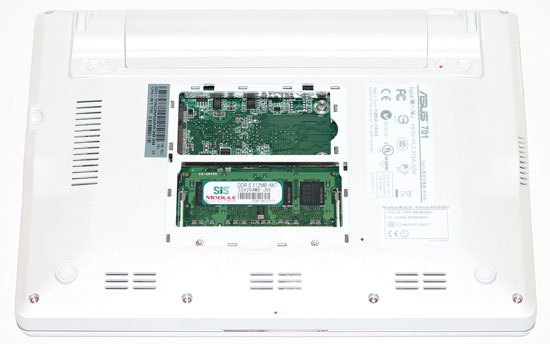 |
The first area you can access - voiding your warranty! - is on the bottom of the laptop. Here you will find a single DDR2 SO-DIMM slot, which on this model comes fitted with 512MB of memory. Above the SO-DIMM slot is a mini PCI slot, at least on the version we received. We have seen information circulating on the Internet that indicates ASUS may have decided to remove the mini PCI slot on later versions; if that's important to you, you will want to do additional research.
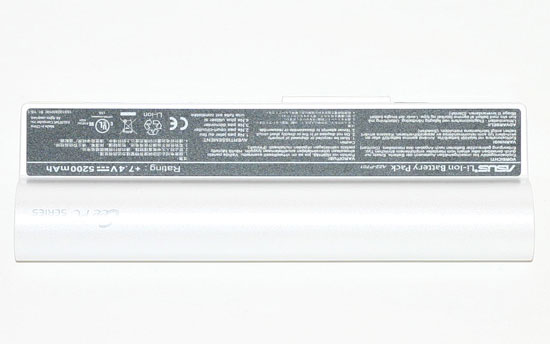 |
Note that there are rumors that the cost reduced version of the Eee PC 4G, the Eee PC 4G Surf, does not have the upgradable memory - there are conflicting reports, so we recommend double-checking before making any purchase. In addition, the 4G Surf lacks the microphone and webcam and it has a smaller battery - 4400 mAh instead of 5200 mAh.
We are rather disappointed that ASUS chose to void the warranty if any user decides to upgrade their memory (though whether they can enforce this remains to be seen). We expect them to release a model in the future with 1GB of RAM, and we know a model with 8GB of solid-state storage is in the works. Still, upgrading your memory is a simple and painless operation that users are capable of doing without damaging anything. Anyway, since we've already voided our "warranty" we might as well continue taking this thing apart.
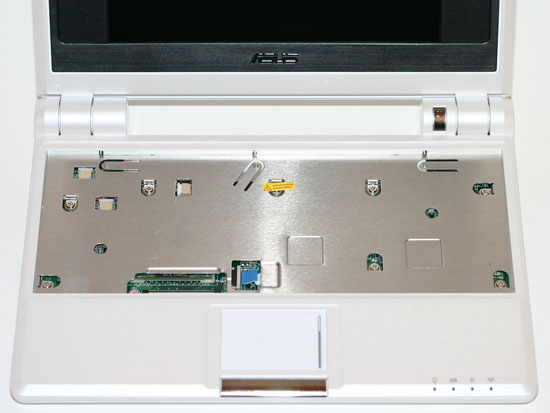 |
The first step is to remove the keyboard; three metal prongs along the top edge hold it in place, and we used a small screwdriver to help with this process. Like all laptop keyboards, a flat data ribbon connects to the motherboard. You'll need to disconnect this in order to continue the dissection process. There's no reason to do so, as the internal components aren't upgradable, but we like taking things apart.
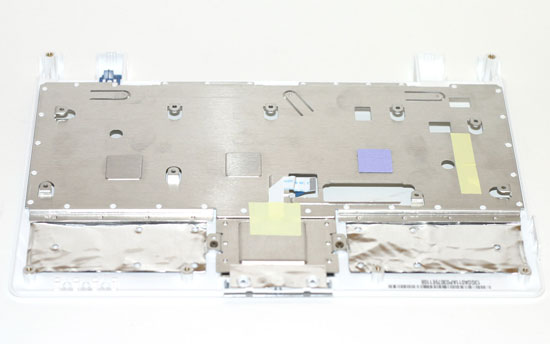 |
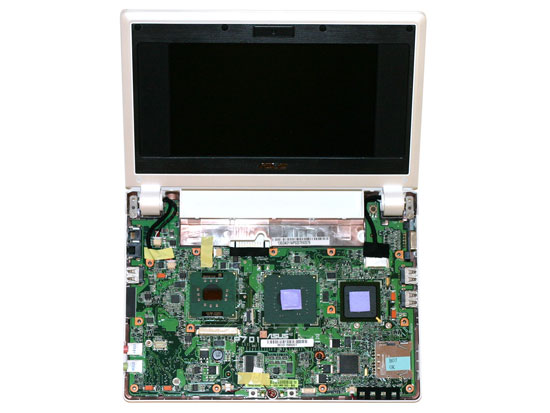 |
Getting at the motherboard proves to be more difficult than usual. Four screws on the bottom and eight screws underneath the keyboard secure the top panel. Besides these 12 screws, however, there are also plastic tabs around the edges that hold the top panel in place. With some patience, a small flat head screwdriver, and some poking and prodding we were able to remove this panel, which also serves as something of a heatsink. We also had to disconnect the small ribbon cable for the touchpad. With that accomplished, we get a nice view of the densely packed motherboard.
 |
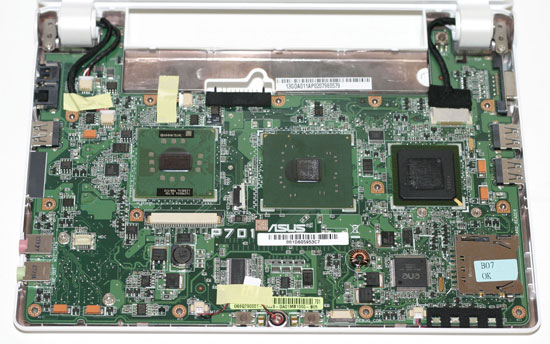 |
Taking a closer look at the motherboard, and removing the heat transfer pads from the middle and right chips, we get to the heart of the Eee PC. The left chip is a 900MHz Celeron M processor, based on the Dothan core with 512K of cache. As reported elsewhere, ASUS underclocks the chip to 630MHz with a 70MHz front side bus. ASUS likely does this to keep temperatures and power requirements in check, although this may change in the future. The center and right chips are the Northbridge and Southbridge.
The center chip is unmarked, but the other two chips are copyright 2003. It's too bad ASUS wasn't able to use a single System-on-a-Chip design; something manufactured using a 45nm process could easily reduce power requirements and improve performance, were such a chip available. Both AMD and Intel are working on such designs, though perhaps it was simply cheaper for ASUS to use old surplus microchips.
If you didn't notice, the flash memory that serves as the main storage is not visible. This should be on the other side of the motherboard, but after some initial attempts at removing the motherboard from the case, we decided discretion was the better course of action. Again, as seen in the above images, there are no user upgradable parts inside anyway.










36 Comments
View All Comments
JarredWalton - Sunday, December 2, 2007 - link
As others have pointed out, this isn't competing in the same market as 15" notebooks, or even 12" models. That's both good and bad - I'd personally take a 12" laptop, but then those start at about 3x the cost of the Eee PC 4G. :|Also, you're correct that 800x480 is not a standard AR. It really doesn't matter too much outside of running certain applications, but 16:10 would really be a 768x480 resolution. You're talking about 16:9, when you say 854x480, which is in some ways just as non-standard. I'd still like something higher, though... 1024x640 would be a lot better. It's amazing what 160 extra pixels in height can do. But then it would be more difficult for vision-impaired people to read the screen.
shadghost - Sunday, December 2, 2007 - link
it is a solid state storage device onto the mb, not any standard form factor, non removabletmx220 - Friday, November 30, 2007 - link
I thought the name for these are subnotebooksor is that not standard yet?
nubie - Friday, November 30, 2007 - link
I don't know where Anand got such WRONG data, this clearly shows upgradeable memory: http://forum.eeeuser.com/viewtopic.php?id=3626">http://forum.eeeuser.com/viewtopic.php?id=3626The 700 is the version that has been showing up without a so-dimm, that is the "$200" version, AFAIK even the 2GB Surf model with 256MB ram is going to be $300 and have the upgradeable RAM.
As far as the "Voided warranty" bit, the only way the designers/engineers were able to get this put on the market is by convincing those in charge that it isn't a computer, the entire company seems to believe it too.
As far as how small it is and how much money and performance, it is much much smaller than a Vostro (like less than half the size), so it isn't really the same thing, do some price-searching on a laptop this size and you will soon see that the price is less than half as expensive as similarly sized models with equal horsepower.
I think we will continue to see ignorant comments comparing it to laptops for a long time (if not forever), simply because these people have never used something as small as a Toshiba Libretto, let me tell you it is a big step up from a Libretto 110CT (233mmx 32/64MB RAM)
I am just really hoping that we get some competition and have more of these for around $300.
WINDOWS CE!!! Screw that, if you don't understand the difference, STFU!!!.
I have struggled to get a CE device to update its OS, you can't do it, you need the MFR to give you the bootloader and the OS restore, and if it gets FUBAR'd, there is nothing you can do. XP/Linux is infinitely better.
Not to mention the ability to use apps/games/utilities, UGH, CE should curl up and die.
psychobriggsy - Saturday, December 1, 2007 - link
It's clear that the costs on this thing can come down a lot once Intel creates an x86 SoC that incorporates the CPU (like this 900MHz Dothan), the northbridge, a GPU, and a southbridge onto the same package, or even the same die. That's three large footprint chips down to one, plus hopefully fewer support chips.It would also allow the footprint to be reduced so that the 7" screen doesn't need a massive border - making it far more portable. That, or allow the speakers to be placed into the base (like on most laptops), and allow a bigger display to be put in - maybe even a 10" 1024x600.
Don't rule out ARM coming up from below either with competitive SoCs. Look at what the iPhone/iPod Touch can do interface-wise, and Linux runs on ARM without any issues.
JarredWalton - Saturday, December 1, 2007 - link
I have made some edits since the first release of this article, addressing many of the items you mention. However, the comparison to a laptop is not without merit. Yes, this is much smaller - I mention that fact several times - but smaller isn't always better. I can type fine on laptops; the Eee PC keyboard isn't quite at the level of a Blackberry, but as a touch typist I find it nearly impossible to type at anything approaching normal speed. So, from ~70-80 WPM down to around 20-25 WPM. Yay!In regards to the warranty, ASUS has a very good policy on all of their other products. The Eee policy by comparison has been castrated. Zero bright dot? Nope! Two year manufacturer warranty? Nope. I haven't spent much time trying to contact the public ASUS groups for support on the Eee, but others are again reporting less than stellar response times. Top that off with a voided warranty if you upgrade the RAM (I smell a class action suit or at least a change to this policy), and you can see the ways in which ASUS has managed to keep costs down.
Again, that doesn't mean the Eee PC doesn't fill a market niche. I've heard PDA wireless can be terribly painful/sporadic, and other than a few minor glitches I experienced no difficult with the Eee. The screen size is also much larger than any PDA, even if it's still a far cry from a "normal" laptop.
Fox5 - Friday, November 30, 2007 - link
As a PDA user of several years who was sold on their "versatility", I'd say PDAs are nearly useless, same as the tablet PC. Both are devices limited by their performance, stability, size, and battery life.My tablet pc didn't get long enough battery life to use for long lectures, was still too heavy/bulky to make it reasonable to carry around, the screen was hard to write on especially near the edges, and program lag and random crashes killed it for me. Replaced it with a notebook and found it far superior.
The PDA was similar, but it was replaced with a memo pad. My PDA now only sees occasional use as a calculator and often as a gps.
Something that had full pc functionality and performance, even if on the bottom end of it like this eee pc, would be a huge step up. A real, high-performance web browser, real office suite, and what not are far beyond what a PDA can offer, and no other device is this light and this cheap. Sure, there are other $400 laptops, but they're not ultraportable, not even portable enough to wear it'd be no bother to just throw them in a bag and bring them along.
Omega215D - Friday, November 30, 2007 - link
I have the Palm T|X and found that using it to finish off papers I was working on was not a good idea. The keyboard is fine but the screen is a bit too small for that. Then there's using the T|X to access the internet. I hate the browser that comes with the device which takes a bit to load web pages.I find that the Asus Eee PC is what I was looking for. Buying a regular laptop for that kind of price would be a pretty big clunker and the other laptops the size of the Eee cost anywhere from $1100 to $2400. I say the Asus has a pretty clear purpose.
walmartshopper - Friday, November 30, 2007 - link
I just got a Vostro 1400 from the Dell outlet for only $600. It has a C2D, 2GB, 120GB, and a Geforce 8400GS. It's still small and light, and the battery lasts up to 7 hours. It can even run Crysis at 800x600 at low quality and get 30fps. I know I'm comparing laptops that have different purposes, but still it just doesn't seem like a good deal to pay $400 for something so crippled.Plus, I would probably get frustrated trying to type on that thing with my big ol' sausage fingers.
johnsonx - Friday, November 30, 2007 - link
If you can get to a console, is rpm available? If so then it should be possible to install any packages you want from the command line.